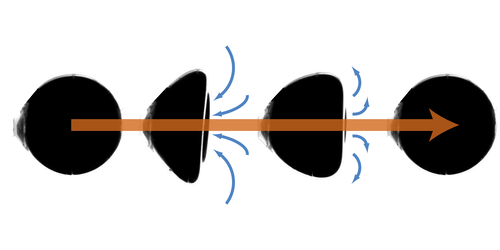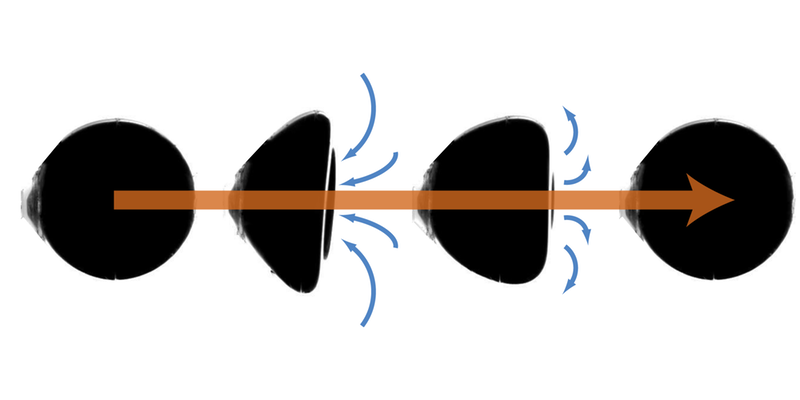Elastic Spherical Shell Can Swim
Microscopic objects that can propel themselves through fluids could have many uses, such as targeted drug delivery in the bloodstream. A new proposal shows that a particularly simple structure—a hollow sphere that repeatedly collapses and restores itself under pressure—can propel itself through a liquid. The researchers demonstrate the effect for a large elastic shell and suggest how it could be miniaturized.
A mechanical “swimmer” must undergo a cyclical series of shape changes in a way that imparts a net thrust. For large objects, net motion can be produced by making the forward stroke faster than the return stroke, but this won’t work for microscopic objects, which experience water as highly viscous. For a tiny swimmer, the reverse movement produces an equal and opposite displacement, regardless of the speed of deformation, so the swimmer can’t get anywhere.
“A small, simple scallop that can only open or close its shell cannot swim, even if it closes the shell much faster than it opens it,” says Gwennou Coupier of Grenoble Alps University and the French National Center for Scientific Research (CNRS). So microscopic swimming devices generally need at least two degrees of freedom—for example, two directions in which to change shape—which makes controlling them potentially more complicated.
But Coupier and his colleagues have found that this limitation can be avoided if the second half of the cycle is not exactly the reverse of the first half, as they found for the simple case of an elastic spherical shell. If the pressure on the outside of the shell is greater than that inside, the shell buckles by dimpling into a bowl shape. But, the researchers showed, unbuckling involves a slightly different sequence of shapes, which allows the sphere to produce a net thrust. So swimming can be induced just by controlling a single parameter: the pressure difference between the inside and the outside of the sphere.
Coupier and colleagues demonstrated this propulsion for a rubbery (elastomeric) spherical balloon 5 cm across, tethered to a support and inflated and deflated by pumped air. When immersed in water, the inflation-deflation cycle of the sphere induced a displacement of nearly 0.7 mm, and when the fluid was 10,000 times as viscous as water, the displacement reached close to 1.4 mm. For viscosities higher than that, the oppositely directed pushes during inflation and deflation largely cancelled out.
However, the two cases of low and high viscosity are not equivalent. In water, the sphere moves by sucking liquid into the dimple with slightly more force than it uses to push it out. But at high viscosity, the thrust comes from friction of the shell surface as it pushes against the surrounding medium. “It’s like when you creep along a narrow tube: you move by friction of your hands and legs on the walls,” says Coupier.
This latter case—the viscous regime—mimics the situation of a sphere 1000 times smaller swimming in water, in which case the viscous effects are correspondingly larger. One way to control the deformations would be to alter the external pressure, for example by passing ultrasound waves through the fluid.
Howard Stone of Princeton University, a specialist in fluid mechanics, says that the evidence for thrust in these spherical systems is new and persuasive. “I can imagine some sort of directed transport where you inject small bubbles, perhaps where drugs are embedded in the shells, and then you direct their motion to some location using an external pressure (sound) source,” he says.
Whether these systems will perform better than microparticles propelled by other mechanisms, such as temperature changes or chemical production of gas from one side—which have already been used for guided drug delivery [1]—remains to be seen. Soft-condensed-matter physicist Ramin Golestanian of the University of Oxford in the UK says that the simple scaling-down argument might not work, as very small hollow particles might experience thermal fluctuations that will make buckling less abrupt and disrupt the creation of thrust.
But Coupier says that he and his colleagues are now pursuing the extension of the approach to microscopic scales, using both commercial “encapsulated bubbles” and tailor-made elastic shells. He says that if such a system can steer drug-filled capsules to their target, they could then be burst by ultrasound waves of greater intensity.
This research is published in Physical Review Letters.
–Philip Ball
Philip Ball is a freelance science writer in London. His latest book is How Life Works (Picador, 2024).
References
- A. Joseph et al., “Chemotactic Synthetic Vesicles: Design and Applications in Blood-Brain Barrier Crossing,” Sci. Adv. 3, e1700362 (2017).
More Information
You Tube video shows the swimmer operating in additional conditions, set to music, and with further explanations.





